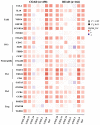Comprehensive analysis of the prognosis and immune infiltration for CXC chemokines in colorectal cancer
- PMID: 34233297
- PMCID: PMC8312455
- DOI: 10.18632/aging.203245
Comprehensive analysis of the prognosis and immune infiltration for CXC chemokines in colorectal cancer
Abstract
The C-X-C motif (CXC) chemokines are a family of chemotactic molecules that have been identified as potential prognostic markers and prospective therapeutic targets for many kinds of cancer types. Increasing evidence shows that CXC chemokines are associated with the progression of colorectal cancer (CRC); however, the correlations of CXC chemokines with prognostic and immune infiltrates in CRC remain to be clarified. In this study, we analyzed the mRNA expression level, prognostic data and immune infiltrates of CXC chemokines in CRC patients from the Gene Expression Profiling Interactive Analysis, Oncomine, cBioPortal and databases using GeneMANIA, STRING, DAVID 6.8, and TIMER. Our results showed that CXCL1/2/3/4/5/8/9/10/11/13/14/16 were significantly overexpressed in CRC tissues. Furthermore, expression of CXCL1/2/3/9/10/11 was associated with tumor stage in CRC. A significant association was also identified between the co-expression of CXCL16 with EGFR, KRAS and NRAS. In addition, the survival analysis suggested that high CXCL2/3/8/9/10/11/14 expression is correlated with clinical outcomes of CRC patients. Moreover, a significant association was observed between the CXCL8/9/10/11 expression and immune infiltration in colonic and rectal adenocarcinoma. Overall, CXC chemokines are not only implicated as prognostic biomarkers for CRC patients, but may also influence the immune status of CRC tissues.
Keywords: CXC chemokines; colorectal cancer; comprehensive analysis; immune infiltration.
Conflict of interest statement
Figures








Similar articles
-
Comprehensive analysis of the expression and prognostic value of CXC chemokines in colorectal cancer.Int Immunopharmacol. 2020 Dec;89(Pt B):107077. doi: 10.1016/j.intimp.2020.107077. Epub 2020 Oct 14. Int Immunopharmacol. 2020. PMID: 33068862
-
Exploration of prognostic biomarkers and therapeutic targets in the microenvironment of bladder cancer based on CXC chemokines.Math Biosci Eng. 2021 Jul 19;18(5):6262-6287. doi: 10.3934/mbe.2021313. Math Biosci Eng. 2021. PMID: 34517533
-
Prognostic Biomarkers and Immunotherapeutic Targets Among CXC Chemokines in Pancreatic Adenocarcinoma.Front Oncol. 2021 Aug 23;11:711402. doi: 10.3389/fonc.2021.711402. eCollection 2021. Front Oncol. 2021. PMID: 34497764 Free PMC article.
-
CXC family of chemokines as prognostic or predictive biomarkers and possible drug targets in colorectal cancer.World J Gastroenterol. 2018 Nov 14;24(42):4738-4749. doi: 10.3748/wjg.v24.i42.4738. World J Gastroenterol. 2018. PMID: 30479461 Free PMC article. Review.
-
The expression and role of CXC chemokines in colorectal cancer.Cytokine Growth Factor Rev. 2011 Oct-Dec;22(5-6):345-58. doi: 10.1016/j.cytogfr.2011.09.002. Epub 2011 Oct 14. Cytokine Growth Factor Rev. 2011. PMID: 22000992 Review.
Cited by
-
The CXCL1-CXCR2 Axis as a Component of Therapy Resistance, a Source of Side Effects in Cancer Treatment, and a Therapeutic Target.Cancers (Basel). 2025 May 15;17(10):1674. doi: 10.3390/cancers17101674. Cancers (Basel). 2025. PMID: 40427171 Free PMC article. Review.
-
Systematic Analysis of CXC Chemokine-Vascular Endothelial Growth Factor A Network in Colonic Adenocarcinoma from the Perspective of Angiogenesis.Biomed Res Int. 2022 Oct 4;2022:5137301. doi: 10.1155/2022/5137301. eCollection 2022. Biomed Res Int. 2022. PMID: 36246978 Free PMC article.
-
CXCL5 and CXCL14, but not CXCL16 as potential biomarkers of colorectal cancer.Sci Rep. 2023 Oct 17;13(1):17688. doi: 10.1038/s41598-023-45093-4. Sci Rep. 2023. PMID: 37848726 Free PMC article.
-
Sensory neuron dysfunction in orthotopic mouse models of colon cancer.J Neuroinflammation. 2022 Aug 12;19(1):204. doi: 10.1186/s12974-022-02566-z. J Neuroinflammation. 2022. PMID: 35962398 Free PMC article.
-
Macrophage Inflammatory Proteins (MIPs) Contribute to Malignant Potential of Colorectal Polyps and Modulate Likelihood of Cancerization Associated with Standard Risk Factors.Int J Mol Sci. 2024 Jan 23;25(3):1383. doi: 10.3390/ijms25031383. Int J Mol Sci. 2024. PMID: 38338661 Free PMC article.
References
Publication types
MeSH terms
Substances
LinkOut - more resources
Full Text Sources
Medical
Research Materials
Miscellaneous

